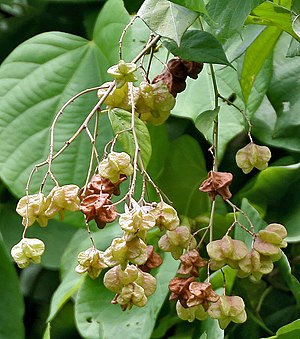Note: This is a project under development. The articles on this wiki are just being initiated and broadly incomplete. You can Help creating new pages.
Difference between revisions of "Kleinhovia hospita - Guest tree"
(→Habit) |
(→References) |
||
| (2 intermediate revisions by the same user not shown) | |||
| Line 1: | Line 1: | ||
[[File:Fruit I IMG 9205.jpg|thumb|right|''Kleinhovia'', ''Guest tree'']] | [[File:Fruit I IMG 9205.jpg|thumb|right|''Kleinhovia'', ''Guest tree'']] | ||
| − | + | '''Kleinhovia hospita''' is an evergreen, tropical tree native to Indonesia, Malaysia and other parts of tropical Asia. It is monotypic, being the only species in the genus Kleinhovia. | |
| − | |||
==Uses== | ==Uses== | ||
{{Uses|Scabies}}, {{Uses|Dyspepsia}}, {{Uses|Cough}}, {{Uses|Asthma}}, {{Uses|Psoriasis}}, {{Uses|Headache}}, {{Uses|Liver diseases}}, {{Uses|Pneumonia}}, {{Uses|Stomachache}}, {{Uses|Tuberculosis}}, {{Uses|Bee stings}}. | {{Uses|Scabies}}, {{Uses|Dyspepsia}}, {{Uses|Cough}}, {{Uses|Asthma}}, {{Uses|Psoriasis}}, {{Uses|Headache}}, {{Uses|Liver diseases}}, {{Uses|Pneumonia}}, {{Uses|Stomachache}}, {{Uses|Tuberculosis}}, {{Uses|Bee stings}}. | ||
| Line 12: | Line 11: | ||
==Common names== | ==Common names== | ||
| − | {{Common names|sa=|en=|gu=|hi=|kn=|ks=|ml=|mr=|pa=|ta=|te=}} | + | {{Common names|sa=|en=Guest tree|gu=|hi=Bhola|kn=|ks=|ml=|mr=|pa=|ta=|te=}} |
==Properties== | ==Properties== | ||
| Line 18: | Line 17: | ||
===Dravya=== | ===Dravya=== | ||
===Rasa=== | ===Rasa=== | ||
| − | |||
===Guna=== | ===Guna=== | ||
| Line 53: | Line 51: | ||
==How to plant/cultivate== | ==How to plant/cultivate== | ||
| − | Propagation is by seed. Cuttings are sometimes said to be difficult to root, which is associated with the presence of an uninterrupted sclerenchym band in the pericycle. <ref name="How to plant/cultivate"/> | + | Propagation is by seed. Cuttings are sometimes said to be difficult to root, which is associated with the presence of an uninterrupted sclerenchym band in the pericycle.<ref name="How to plant/cultivate"/> |
==Commonly seen growing in areas== | ==Commonly seen growing in areas== | ||
| Line 70: | Line 68: | ||
<references> | <references> | ||
| − | <ref name="chemical composition">[ | + | <ref name="chemical composition">[Chemistry]</ref> |
| − | <ref name="Leaf">[ | + | <ref name="Leaf">[Morphology]</ref> |
| − | <ref name="How to plant/cultivate">[https://uses.plantnet-project.org/en/Kleinhovia_hospita_(PROSEA) | + | <ref name="How to plant/cultivate">[https://uses.plantnet-project.org/en/Kleinhovia_hospita_(PROSEA) Cultivation details]</ref> |
</references> | </references> | ||
Latest revision as of 10:48, 29 May 2020
Kleinhovia hospita is an evergreen, tropical tree native to Indonesia, Malaysia and other parts of tropical Asia. It is monotypic, being the only species in the genus Kleinhovia.
Contents
- 1 Uses
- 2 Parts Used
- 3 Chemical Composition
- 4 Common names
- 5 Properties
- 6 Habit
- 7 Identification
- 8 List of Ayurvedic medicine in which the herb is used
- 9 Where to get the saplings
- 10 Mode of Propagation
- 11 How to plant/cultivate
- 12 Commonly seen growing in areas
- 13 Photo Gallery
- 14 References
- 15 External Links
Uses
Scabies, Dyspepsia, Cough, Asthma, Psoriasis, Headache, Liver diseases, Pneumonia, Stomachache, Tuberculosis, Bee stings.
Parts Used
Chemical Composition
Common names
| Language | Common name |
|---|---|
| Kannada | |
| Hindi | Bhola |
| Malayalam | |
| Tamil | |
| Telugu | |
| Marathi | |
| Gujarathi | |
| Punjabi | |
| Kashmiri | |
| Sanskrit | |
| English | Guest tree |
Properties
Reference: Dravya - Substance, Rasa - Taste, Guna - Qualities, Veerya - Potency, Vipaka - Post-digesion effect, Karma - Pharmacological activity, Prabhava - Therepeutics.
Dravya
Rasa
Guna
Veerya
Vipaka
Karma
Prabhava
Habit
Identification
Leaf
| Kind | Shape | Feature |
|---|---|---|
Flower
| Type | Size | Color and composition | Stamen | More information |
|---|---|---|---|---|
| {{{5}}} |
Fruit
| Type | Size | Mass | Appearance | Seeds | More information |
|---|---|---|---|---|---|
Other features
List of Ayurvedic medicine in which the herb is used
Where to get the saplings
Mode of Propagation
How to plant/cultivate
Propagation is by seed. Cuttings are sometimes said to be difficult to root, which is associated with the presence of an uninterrupted sclerenchym band in the pericycle.[3]
Commonly seen growing in areas
[[:Category:Herbs that are commonly seen in the region of |]], [[:Category:Herbs that are commonly seen in the region of |]], [[:Category:Herbs that are commonly seen in the region of |]], [[:Category:Herbs that are commonly seen in the region of |]], [[:Category:Herbs that are commonly seen in the region of |]].
Photo Gallery
References
- ↑ [Chemistry]
- ↑ [Morphology]
- ↑ Cultivation details
External Links
- Ayurvedic Herbs known to be helpful to treat Scabies
- Ayurvedic Herbs known to be helpful to treat Dyspepsia
- Ayurvedic Herbs known to be helpful to treat Cough
- Ayurvedic Herbs known to be helpful to treat Asthma
- Ayurvedic Herbs known to be helpful to treat Psoriasis
- Ayurvedic Herbs known to be helpful to treat Headache
- Ayurvedic Herbs known to be helpful to treat Liver diseases
- Ayurvedic Herbs known to be helpful to treat Pneumonia
- Ayurvedic Herbs known to be helpful to treat Stomachache
- Ayurvedic Herbs known to be helpful to treat Tuberculosis
- Ayurvedic Herbs known to be helpful to treat Bee stings
- Herbs with Stem used in medicine
- Herbs with Leaves used in medicine
- Herbs with Root used in medicine
- Herbs with common name in Hindi
- Herbs with common name in English
- Habit - Tree
- Index of Plants which can be propagated by Seeds
- Index of Plants which can be propagated by Stem cuttings
- Herbs that are commonly seen in the region of
- Herbs
- Ayurvedic herbs that don't have seed photos
- Malvaceae





